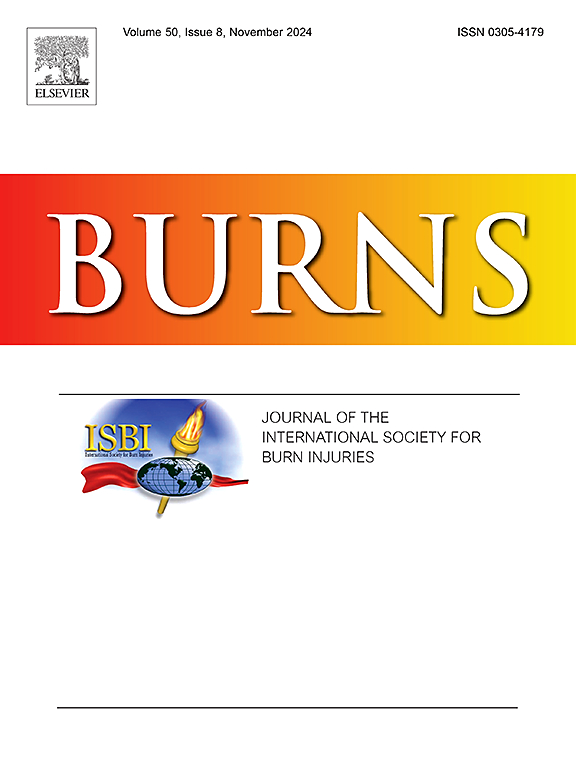Incidence and delirium risk factors in burn patients: A prospective cohort study
IF 3.2
3区 医学
Q2 CRITICAL CARE MEDICINE
引用次数: 0
Abstract
Background
Delirium is a neurocognitive syndrome caused by systemic disturbances, leading to impaired attention, awareness, and/or cognition. It poses a significant risk of comorbidities, mortality, prolonged hospitalization, and increased healthcare costs. The challenges in delirium management, follow-up, and rehabilitation, arising from complex chronic conditions and long-term complications after severe burns, highlight the urgent need for more research in this area. Thus, this study aims to investigate the incidence of delirium and the risk factors specific to this population.
Methods
This analytical observational prospective cohort study was conducted between August 2022 and January 2024. Adults (18 years and older) admitted to a single burn unit with a confirmed burn injury were included, regardless of burn severity. Sociodemographic and clinical variables included age, sex, extent of burn, and prior health status. Delirium assessment was made using the CAM-ICU scale at least twice a day. The primary outcome was the incidence of delirium and its risk factors, with secondary outcomes including the onset and duration of delirium episodes.
Results/Discussion
The sample consisted of 50 patients, with a delirium incidence of 52 %. Burn patients admitted to the burn unit developed delirium an average of 11.81 days (95 % CI=7.09–16.52) after hospitalization, with an average duration of 11.5 days (95 % CI = 7.28–15.72). Age was the only predisposing risk factor that emerged (p = 0.0141). Five variables emerged as precipitating risk factors in bivariate analyses: total surface burn area (TSBA) (p = 0.026), surgery (p = 0.0438), mechanical ventilation (p < 0.001), opioid infusion use (p < 0.001), and infection (p < 0.001). However, in multivariate Cox regression analyses, only mechanical ventilation remained statistically significant as a risk factor for delirium (HR=8.017; 95 % CI = 1.926 – 33.368; p = 0.004).
Conclusion
This study highlights mechanical ventilation as a critical risk factor contributing to the high incidence of delirium among burn patients. Early identification and management of risk factors—mainly mechanical ventilation, but also TSBA, surgery, opioid infusion use, and infection—can guide targeted interventions to improve patient outcomes and mitigate the impact of delirium on recovery.
烧伤患者的发病率和谵妄危险因素:一项前瞻性队列研究
背景:谵妄是一种由全身性障碍引起的神经认知综合征,可导致注意力、意识和/或认知功能受损。它具有显著的合并症、死亡率、住院时间延长和医疗费用增加的风险。严重烧伤后复杂的慢性疾病和长期并发症在谵妄管理、随访和康复方面面临挑战,迫切需要在这一领域进行更多的研究。因此,本研究的目的是调查谵妄的发生率和特定的危险因素,这一人群。方法该分析性观察性前瞻性队列研究于2022年8月至2024年1月进行。成年人(18岁及以上)入住一个单一的烧伤单位确认烧伤,无论烧伤严重程度。社会人口学和临床变量包括年龄、性别、烧伤程度和既往健康状况。谵妄评估采用CAM-ICU量表,每天至少2次。主要结局是谵妄的发生率及其危险因素,次要结局包括谵妄发作的发生和持续时间。结果/讨论样本包括50例患者,谵妄发生率为52. %。烧伤患者入院后出现谵妄的平均时间为11.81天(95 % CI= 7.09-16.52),平均持续时间为11.5天(95 % CI= 7.28-15.72)。年龄是唯一的易感危险因素(p = 0.0141)。五个变量成为诱发危险因素在双变量分析:表面烧伤总面积(TSBA) (p = 0.026),手术(p = 0.0438),机械通气(p & lt; 0.001),阿片类药物输注使用(p & lt; 0.001),和感染(p & lt; 0.001)。然而,在多变量Cox回归分析中,只有机械通气作为谵妄的危险因素仍然具有统计学意义(HR=8.017;95 % ci = 1.926 - 33.368; = 0.004页)。结论机械通气是烧伤患者谵妄高发的重要危险因素。早期识别和管理危险因素——主要是机械通气,但也包括TSBA、手术、阿片类药物输注和感染——可以指导有针对性的干预措施,以改善患者的预后,减轻谵妄对康复的影响。
本文章由计算机程序翻译,如有差异,请以英文原文为准。
求助全文
约1分钟内获得全文
求助全文
来源期刊

Burns
医学-皮肤病学
CiteScore
4.50
自引率
18.50%
发文量
304
审稿时长
72 days
期刊介绍:
Burns aims to foster the exchange of information among all engaged in preventing and treating the effects of burns. The journal focuses on clinical, scientific and social aspects of these injuries and covers the prevention of the injury, the epidemiology of such injuries and all aspects of treatment including development of new techniques and technologies and verification of existing ones. Regular features include clinical and scientific papers, state of the art reviews and descriptions of burn-care in practice.
Topics covered by Burns include: the effects of smoke on man and animals, their tissues and cells; the responses to and treatment of patients and animals with chemical injuries to the skin; the biological and clinical effects of cold injuries; surgical techniques which are, or may be relevant to the treatment of burned patients during the acute or reconstructive phase following injury; well controlled laboratory studies of the effectiveness of anti-microbial agents on infection and new materials on scarring and healing; inflammatory responses to injury, effectiveness of related agents and other compounds used to modify the physiological and cellular responses to the injury; experimental studies of burns and the outcome of burn wound healing; regenerative medicine concerning the skin.
 求助内容:
求助内容: 应助结果提醒方式:
应助结果提醒方式:


